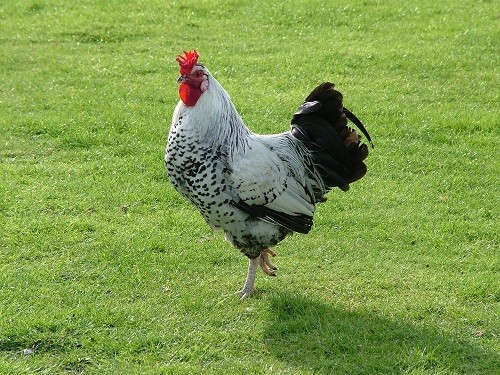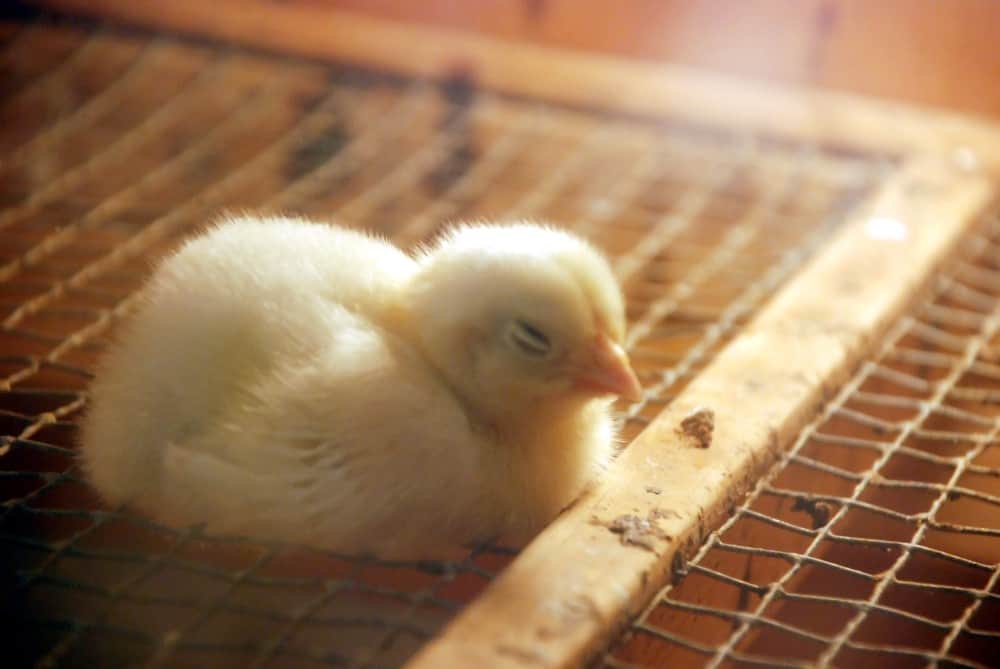There are many things to know about raising chickens in your backyard. Beginner chicken keepers may be surprised to learn how much goes into being a chicken keeper. The great news is once you have everything set up, it gets easier. Your day-to-day responsibilities will include caring for your flock.
Whether you raise egg-laying chickens, meat chickens, or consider them more as pets, chickens require these things.
- Access to clean water
- Nutritious foods
- Shelter from weather and predators (including hawks, owls, eagles)
- Fresh air
- Companionship: Raise at least three hens
- Nesting boxes or safe spaces to lay their eggs – though they may lay them anywhere
- Health checkups – can be done by you, checking on their well-being
- Regular coop cleaning
- Bonus: Areas to forage for food, chicken run, etc.
- Bonus: Mental and physical stimulation — discarded trees, pine needles, straw, treats, chicken swing or chicken toys, perch, roosting bar
Chickens have long been part of the world’s history. They are believed to be domesticated for cockfighting purposes, initially, before becoming food sources. Today, they serve as eggs, meat, as pets, for exhibition and show across the globe. Best Chicken Breeds
Facts About Raising Chickens
Scientifically known as Gallus domesticus, the chicken is said to have been first tamed in China around 6000 BC. Four thousand years later, flocks of them moved to India, eventually spreading to other parts of the world.
The bird as a male adult is called a rooster, while its female counterpart is called a hen. You can eat hens and roosters though some breeds are better for their meat than their eggs. Young chickens, newly-hatched ones in particular, are called chicks.
One type of chicken subject to Chinese-origin debate is the Chinese Silkie chicken, which are popular for their dark meat. It is unknown whether or not they originated from China, where they are called “wu go ji”.
Their dark flesh is attributed to a condition called genetic fibromelanosis, which causes extreme pigmentation of cells. Chickens abide by a rigid social system referred to as the “pecking order”.
This structure puts one bird dominant over another. This can be easily observed while feeding. Choosing friendly breeds will help ensure a harmonious flock. Dominant birds will be intimidating, pecking at submissive ones, stealing their food or chasing them away.
Though it may sound weird, chickens are also touted to be the closest living relative of the Tyrannosaurus rex – arguably the most popular dinosaur thanks to popular culture. The link lies in the oldest proteins ever found, contained in the remains of an adolescent female T. Rex which lived 68 million years from the past.
As it turns out, the protein’s chemical structure reveals an evolutionary relation between chickens and the dinosaurs that reigned during the Cretaceous Period.
The fossil, a T. Rex’s leg bone, is unearthed in 2003 by Jack Horner of the Museum of the Rockies. It was found at the Hell Creek Formation, an area that spans Montana, North Dakota, South Dakota and Wyoming.
Chickens have their own “language” too, in the form of about 30 distinct vocalizations used for communication.
But what’s even more interesting is the fact that they are able to communicate even before their birth. Through a purring sound, the mother hen “talks” to her eggs, and the unborn chicks respond through peeps – short, soft and high-pitched sounds.
It must also be pointed that chickens are not “dumb”. In fact, mother hens serve as good examples by teaching their chicks not to consume grains which could be bad for them.
In addition, they tend to copy the behavior of other chickens, which could be helpful in some cases.
But perhaps the most fascinating fact about these birds is that they are able to recognize up to 100 faces, so the next time you see one, be sure you are remembered.

Chickens Mating
How do chickens mate?
It all starts with their own version of “courting”, of course.
This is actually simple – the rooster tries to impress the hen through a series of movements that highlight his beauty and strength.
Unfortunately, most hens just walk away, but things can get into a more aggressive turn and result to an engagement activity/position known as “treading”.
The rooster gets into a piggy-back position; he stands on the hen’s back and restrains her neck feathers.
It is vital for him to maintain balance in this event.
The hen lowers herself, spreads her wings to the side and allows him to hop to deliver sperm.
Chickens mate without copulatory organs, though the rooster has a pair of testes, and the hen has a pair of ovaries.
Both sexes instead have an external orifice called cloaca.
As these touch together, the rooster transfers sperm into the hen’s reproductive tract.
This is called the “cloacal kiss”, and after the act, each return to his/her own business.
Sperm lives inside the hen’s oviduct for about a month.
Chickens Laying Eggs
One of the most puzzling questions to mankind – which often comes as a joke – asks which among the chicken and the egg came first.
Surprisingly, this inquiry has been raised since 384 BC, and some of the most well-known people from history have expressed their responses to the circular reference.
Aristotle claimed that both had always existed.
Theoretical physicist Stephen Hawking said it’s the egg that came first.
However, it was discovered in 2010 that eggs cannot be produced without a protein called Ovocleidin-17.
This protein, meanwhile, is produced by chickens, which appears to support the stance that the winged, grown birds are first to exist on earth.
Still, this is emphasized to be inconclusive, leaving the mystery unsolved in millennia.
Hens begin laying eggs about 18 to 21 weeks (nearly 6 months) after their own hatching.
It is important to learn, however, that they are able to produce eggs even without the presence of a rooster.
It takes about a day for one hen to make an egg, and she is able to produce another an hour or less later.
But for a hen to produce fertile, hatchable eggs, a rooster will be necessary.
Roosters reach sexual maturity in about 4 to 5 months of age and can remain fertile for years.
The egg-laying process begins with a small gland located near the hen’s eye.
This gland is photosensitive; light triggers the release of eggs.
A fully-formed egg is pushed through muscular contraction.
It goes out through the same channel as the hen’s waste, but there’s nothing to worry here.
Only one canal access is allowed to the vent every time.
Eggs come in consistent shape as they follow the form of the hen’s uterus.
This might be disturbing, but chickens, sometimes, eat eggs.
This happens mostly when an egg is broken by accident.
For human consumption, eggs should be gathered daily and refrigerated quickly to ensure freshness.
Chickens Laying Eggs With No Shell
Chickens That Lay Blue Eggs
Araucanas, Ameraucanas and Cream Legbars are three breeds of chicken that lay blue eggs.
This hue is caused by a pigment called oocyanin (sometimes called oocyan) which goes through the shell.
This pigment is a by-product of bile production. As a result, the shell will be blue inside and outside.
Interestingly, researchers have found that blue eggs actually happened because of a harmless retrovirus.
It is said to be a 500-year-old mutation that began in South America and China, which explains why some breeds in areas of both regions produce such eggs to date.
This particular virus, called EAV-HP, mixes its own genetic data into the host through a backward process; it uses its RNA to create DNA that is later integrated into the host’s DNA.
Nevertheless, the occurrence of blue eggs must not be treated as a rare occasion or a supernatural event.
Color has little to do with nutrition, as blue eggs contain approximately as much cholesterol as other eggs.
Each contain about 185 milligram of cholesterol, which supplies around 60% of the total amount recommended for healthy adults daily.
It is said that blue eggs will not raise blood cholesterol levels significantly; saturated and trans fats have greater effect on one’s total and “bad” cholesterol.
Chickens Hatchery
In essence, a chicken hatchery is a haven for hatching and incubating eggs.
In general, hatcheries are developed to serve different purposes – from ensuring food supply to maintaining conservation.
For live, young animals, these environments function as “nurseries”, becoming their home until they are ready to be moved to other locations.
Chicken hatcheries are often manned by veterinarians and biologists, supervising workers who do most of the ground work.
Activities include safe and proper handling of eggs, monitoring of incubation and provision of nutrition, water and extra needs to older chickens, among others.
Hatcheries must remain sanitary at all times, to ensure the health of the eggs, birds and humans within.
Starting a chicken hatchery is among the many routes of poultry production.
It can be difficult, but with the right information, hardwork and patience, it can be a good source of income.
Caring for the parent flock is perhaps the earliest consideration to keep in mind, alongside a well-planned financial management system.
Note that chicken hatcheries need not be limited to chickens, as it can also house other types of poultry birds such as turkeys (Turkey Eggs) and ducks.
While sanitary principles may be the same, care for these other birds will require different procedures.
As a staple food source, chickens have certainly become part of our lives, providing nourishment to many parts of the world.
Because their life is essentially a cycle, proper care must be consistent, whether it’s for a grown chicken or a hatching egg.
When one finds value in both, whichever came first will no longer matter.
The beauty of these birds, after all, is enough to be thankful for.
Keeping Chickens: Tips for a Healthy Brood
Whether you are keeping chickens for eggs, as pets, or for meat, there are easy things you can do to keep them healthy, clean and safe.
Let’s take a look at 10 tips for keeping chickens safe from predators and healthy all year long.
Keeping Chickens Safe From Predators
Throughout the day, your chickens should be secured within a fenced area with at least a 7-foot high enclosure.
Although not always practical, it’s best if they’re at least semi-monitored whenever they’re out of the Best Chicken Coops.
Before dusk, you should round up your chickens, count them and secure them for the night.
During night hours, your chickens should remain in a durable and completely enclosed coop.
You’ll want more than a single layer of chicken wire to secure your fowl.
Use a 1-inch thick wire mesh around areas that are not solid.
Be especially mindful of raccoons as you enclose your chickens, as they have tiny agile hands that can stretch into narrow spaces.

Housing Your Chickens
Whether you raise your own chickens for their fresh eggs, to make up healthy chicken recipes or as beloved pets, you want them healthy, happy and safe.
You’ll want to make sure you have a sturdy chicken coop that’s easy to clean, sheltered from the elements and secure from predators.
Concrete is ideal for the flooring, as it’s simplest to clean.
Keep Your Chicken Coop Clean and Poop-Free
The frequency of cleaning depends on a few factors such as the number of chickens in the coop and the size of the coop.
To reduce the chances of spreading illness from chicken to chicken, you’ll want to clean the poop from your chicken coop at least three times a week. And spot clean if needed daily.
Use gloves, with a broom, shovel or bucket to clear away chicken feces from the coop as needed.
Make it a point to at least eyeball the coop daily.
And make a plan to deep clean your chicken coop twice a year.
How to Build a Duck House – Helpful Guide for Beginners
Age-Specific Feed For Your Chicks
You may already know the basics for caring for livestock, but one thing you might not know is that, just like you, your chickens need certain nutrition to stay healthy.
And chickens need different nutrition at different stages of their lives.
Baby chicks especially should have a specialized diet called a start or grower diet until at least 5 months old.
This feed is high in fat and protein for their growth needs.
You should feed your chickens a diet of pellet or crushed feed specifically designed to meet their nutritional requirements.
You should feed them daily and allow them to eat as much as they want.
Feed For Your Egg-Laying Hens
When it comes to sustainability and raising your livestock, your egg-laying hens help out tremendously.
Laying hens have extremely high demands for protein, calcium, and vitamins because of the energy it takes for this task.
Use a special “laying” diet for your hens.
The beauty behind having laying hens is you don’t have to worry about what the egg cartons mean when they claim to be cage-free, free-range, pasture-raised or organic.
You know exactly where your eggs are coming from.
Feed For Non-Laying Hens and Cocks
While your egg-laying hens need high calcium for their job, cocks and non-laying hens will not benefit from the same diet.
Cocks and non-laying hens need what’s called a maintenance diet.
It’s much lower in calcium than the laying diet.
If you have trouble finding a maintenance feed, you can use some of the laying feed in conjunction with fresh vegetables and fruits and 20-25% scratch of corn or seeds.
Foods You Should Avoid Feeding Your Chickens Completely
The following foods can be harmful and even toxic to your chickens.
Raw or Dried Beans
These contain a toxin that will kill your chicken, and there’s no saving them.
Keep your chickens clear of any bean plants because they’ll nip at anything in sight.
Moldy Foods
This one can be hit or miss, but just don’t test it.
Be sure to clear out any foods from your chicken’s feeding area left over from the previous day.
Avocado
Although parts of the avocado may be okay in moderation, this is one you probably want to avoid altogether.
Just don’t do it.
Green Tomatoes and Green Potatoes
These have toxins that will kill your chickens in even small amounts.
Green potatoes can be harmful to human health, as well.
Citrus
Do not feed your chicks or chickens any citrus fruits, including citrus seeds and peels.
Chocolate
Chocolate contains caffeine and theobromine, both of which aren’t good for your chickens.
Tiny pieces may not have adverse effects, but best to keep your chickens from all chocolate.
This especially goes for dark varieties, as this has the highest content of caffeine and theobromine.
Healthy Wandering Environment
When keeping chickens, you want them to be able to get good exercise and fresh air.
Your chicken coop should be well-ventilated, spacious and insulated for warmth during the cold months.
Allot at least 9 square feet per chicken.
Keep chicken toys available for them, such as handmade tunnels, chicken swings or CDs hanging on strings for them to play with.
Remember, chickens will try to eat just about anything left in their line of sight.
Keep gasoline, oil, screws, fertilizer, bits of wire and pesticides away from your chicken’s play area.
Rooster Per 9 Hens
If you’re wanting to mate your chickens to produce offspring, you really only need one cock for every 9-10 hens.
Roosters do tend to be noisy and territorial, so you probably don’t want to have any more than you have to for the job.
Keeping Chickens Disease-Free
You’ll want to pay close attention to your chicken’s physical appearance and energy levels.
This will help you get a sense of what each chicken’s “baseline” is in terms of wellness and illness.
Watch your chicken’s weight and sift through feathers to check for parasites or feathers falling out.
Notice any sneezing or appetite changes, as well.
Keeping Your Chickens Healthy All Year Long
Whether you’re wanting fresh eggs, tender meat or pet chickens, you’ll want to keep them happy, healthy and safe.
Did you know 1% of urban dwellers own chickens on less than 1 acre of land and another 4% plan to join this poultry trend in the next 5 years?
This may not appear very high at first glance.
But when you consider the crowded environment of the city and the compact feel of side-by-side housing, 5% can seem quite high.
It can be difficult to keep your chickens healthy and happy under these conditions.
But it can be done.
For more tips and information on keeping chickens and other livestock, check us out at Rural Living Today.
Learn more:
- Beating Food Challenges with Chicken Eggs
- How To Raise Backyard Chickens
- 5 Important Tips on Raising Roosters
- Successful Hen and Chick Adoption
- 10 Tips for Raising Backyard Chickens for Beginners
- Pros and Cons of Keeping a Rooster
- Comparing the Best Chicken Swings
- Best Chicken Toys: Entertaining Your Backyard Chickens
- How Much Space Do Chickens Need

